This web page contains the log of the first leg from a sailing trip that I took with S/Y Thetis from Greece to Tunisia and back. The leg covers a 6-day period of solo sailing in the Greek Aegean from the island of Leros to the island of Kythera via Donousa, Dhespotico and Sifnos.
The log is illustrated with maps and photographs, and also includes some historical and geographical descriptions of the places visited as well as several links to other related web sites.
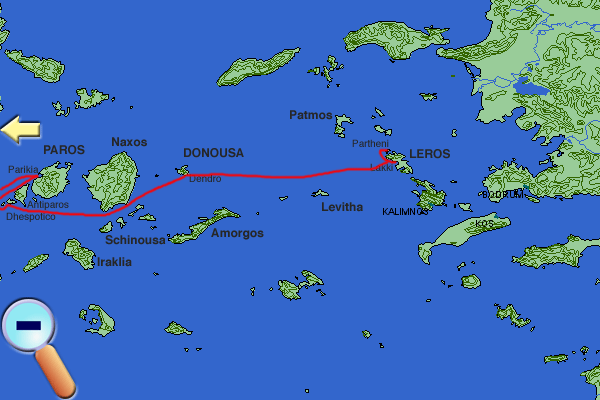
Friday May 4, 2001, Day 1
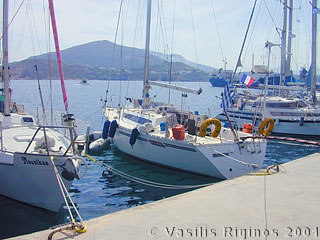
I departed from Lakki, Leros at 1005. The departure was very easy since I had the help of Vasilis, Agmar Marine (renamed Moor & Dock) co-owner. I was on a heading of 269° for Donousa. I decided not to stay at a nearby island, as I was planning, but to take advantage of the nice weather and put the notorious Sea of Ikaria behind me. The wind was a light northerly of 8-12 knots. I had already raised the main and I was now motor-sailing in calm seas.
Later I opened the genoa and I even turned off the motor for a short period. The left headsail winch did not latch. About 10 M from Donousa 3 dolphins approached Thetis, and played with her bow wave. This was a good omen! This is the good life!
We arrived at Dentro, Donousa [37° 05.8' N 25° 48.3' E] at 1640 after 50.1 M. There was hardly any wind and I anchored at 7 m depth without any trouble. There were three other sailboats in this lovely anchorage, two of which I recognized: the German Pepita that I had met 2 years ago in Arki (they had just returned from the Karya Rally of the Black Sea) and a small British sailboat that was in Lakki few days ago. The cruising world is indeed small.
My first passage this year had been successfully concluded, may there be more and as smooth as this one. After picking up and covering the sails, I treated myself to well deserved ouzo. Then I started cooking. While in Samos, I had bought some chicken breasts and had pre-cooked them, now I finished cooking one of them in a piquant sauce of balsamic vinegar, capers, onions, and mustard. I served them with a rice pilaf and some red wine. While drinking the wine I made a toast to Poseidon wishing for a good cruising season and fair winds to Tunisia.
I spoke on the phone with Manos. He will be meeting me on the 9th in Kythera and he will be bringing with him the missing flares. All was well except the Navtex forecast. It called for SE near gale winds starting tomorrow. We shall see.
By and large, I was very pleased with the work done on Thetis by Agmar Marine. They are quite a contrast to the Olympic Marine in Lavrio. Olympic never managed to complete more then half of what I had asked them and that at a high price and sloppily. Agmar on the other hand had done all I asked, with good workmanship, and at a more reasonable price.
I opened the port (left) headsail winch to see if I could find out what was wrong with it but I could not see anything. All its parts seemed normal. Since I had never opened one of these before, I could not be too sure. I even called my brother Nikos for advice but he only confirmed that I was opening it properly. After 3 times disassembling and reassembling the winch to no avail I gave up.
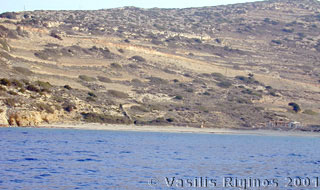
There was still plenty of work to be done on Thetis but I was too tired to do anything today. This cove is a wonderful anchorage, the beach is a favorite place of British campers/nature lovers who spend their day naked absorbing the sun. They have always been a quiet lot. Now it is still too early in the season and the beach is deserted. But there is now a new feature. In the place where on other occasions were the tents of the campers, now there was a new concrete skeleton. Next to it there was a bulldozer and a cement mixer. I am afraid that these monsters are about to devour this lovely beach. In my mind’s eye I could already see unpleasant images of loud disco music and an ugly hotel.
Saturday May 5, 2001, Day 2
Thetis is under sail with both sails open and she is gliding smoothly on the calm waters. My intention was not to leave Donousa but to spend the day there taking care of a growing “to do” list. Unfortunately, just as the Navtex had predicted, the SE wind came in the early morning hours with 10-15 knots which was enough to bring a very uncomfortable swell to the cove which is exposed to the south. I woke up at 0500 and made sure that the anchor was holding. The other boats had already left. It was too uncomfortable to go back to sleep, so I decided to leave the anchorage. In the mean time, a new Navtex forecast had arrived predicting that the wind will become a westerly near-gale. This made me decide to head for either Iraklia or Dhespotiko both of which have anchorages well protected from the westerlies and the southerlies.
Yesterday during the passage from Leros, I had noticed a quantity of water in the bilge. It was not salty so I was not duly alarmed and I pumped it out. I assumed that it was either rain water or wash water and not from a leak of the fresh water tanks. Before leaving today, I removed all the floor boards, unplugged all the drains between the bilge compartments, and pumped out all the remaining water. In a few hours I should know for sure if there is any leakage problem.
I raised the anchor and departed from Dentro on 0745. I raised the mainsail and opened the genoa. Fortunately we were on starboard (right) tack and the headsail sheet used the winch that works. There was enough wind to sail. It was very nice not to hear the bloody engine.
While under way, I primed the watermaker and started it. It worked fine. The new stainless steel T-joints were working well and there were no leaks.
As we were approaching Schinousa the wind shifted to the N and diminished to 4-5 knots. I had to roll in the headsail and motor-sail. After clearing the southernmost point of Naxos, at 1120, the wind came from the ENE at 15-20 knots and some white caps appeared. I decided to continue to Dhespotico. Accordingly I turned off the motor and sailed with the main only.
After a while the wind veered again now coming from the E and increased in strength. I reefed the sail as the wind kept on increasing I went from the 1st reef to the 2nd and then to the 3rd. The wind by that time was over 40 knots and the seas went from calm to quite large. During these reefing operations the winch handle slipped off my hands and fell into the blue void. Fortunately I carry several spares. The ride, almost a run, was not uncomfortable. No new water entered the bilge so my original assessment appeared to be correct.
We reached Dhespotico at 1420. After entering the protected channel between Dhespotico island and Antiparos, the sea was calm but the wind was gusting violently with very frequent gusts exceeding 65 knots. I turned on the motor and headed into the wind to lower the sail. During this operation we were hit by an exceptionally violent gust and the sail flapped with such force that several of its plastic slides broke. I was lucky that the actual sail did not tear. Unfortunately, I did not have enough spare slides so, in effect, I was left without the main sail.
It seemed to me that the anchorage with this strong wind was not tenable and I decided to head for the well protected main port of Paros, Paroikia. Maybe that was a mistake and I should have stayed. At any rate, I motored around the island and headed N for Paroikia some 16 M away. We reached the bay of Paroikia at 1730. The conditions were beyond description and unlike any that I had experienced in all my years of sailing. The wind, now from the ESE was a steady 50 knots with gusts over 90! This is hurricane force. Around the reefs that envelope the harbor there was heavy mist which looked like thick fog. It was not fog but spray. The harbor, less than a mile away, was completely invisible. To approach the harbor I had to head into this wind. Every attempt to do so was futile. With the engine at full throttle, Thetis would veer away. There was no headway and no rudder control. Tacking was out of the question. The harbor was totally untenable.
With hindsight I now think that it was a grave mistake to even try to approach land under such hurricane-like conditions. Had I come closer to the shore and then lost control of the boat I could had been into very serious trouble. I was fortunate to have lost control at least one mile away and not near one of the reefs which were invisible in the spray. I should had immediately headed out to sea as I finally did.
I was very tired. I first decided to head SW toward Sifnos but this heading was very close to the wind which became more southerly as we moved away from Paros. We were making very slow headway, less than 2 knots. I was not sure which anchorage would be more secure under these conditions. Remember that most anchorages in the Cyclades are well protected from the north winds but are exposed to the south. My calculations were further confused because although I was experiencing the most severe SE gale the forecast was still calling for a westerly gale. So, I needed an anchorage that would protect me from both. I considered going to Serifos which would be even less of a beat or even going N to Kithnos but again I was not too sure of the final protection. Needless to say, I was shaken from my experience near Paros.
I changed course toward Serifos and tried to call my brother Nikos for a second opinion. No answer. In the mean time, over the VHF I could hear a number of ships in the near area issuing distress calls. Not too reassuring! The waves by that time were large, towering over Thetis. I even considered heading to Finikas in Syros. Finally, I got through the GSM phone to Rozina, Nikos’ friend. Shortly she had located Nikos and he was on the line. He advised me to go to Faros in Sifnos some 16 M away from my present position. I have never anchored in Faros. Following his advice I changed course once again and was back to less than 2 knots ground speed. Also, after looking into the charts and pilot books, I started having second thoughts about how protected from the SE we will be in Faros and what the approach to the cove would be like. I considered spending the night out at sea, but with the loss of the main sail I could not hove-to.
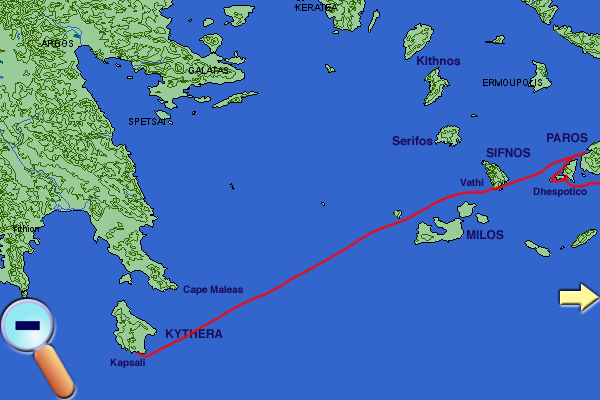
The situation slowly improved. As we crawled away from Paros the wind subsided to only 45 knots and the near full moon rose behind the scattered clouds. Our headway improved to over 2 knots. Nikos called back. He had spoken to the meteorological service and with several of his friends very familiar with Sifnos. The revised considered opinion now was that I would be better protected in Vathi and not in Faros. I liked this idea much better because although Vathi was 6 more miles further away, it is an anchorage with which I was very familiar.
I decided to head for Vathi, although it is somewhat exposed to the west. In the mean time the meteorological service had revised their forecast and now called for a severe SE gale. No kidding! The wind shifted back to SE, and I was now able to open a tiny amount of my headsail. This made a huge difference both in stability and in speed. We now made 5 knots. The seas were still large, and every so often copious amounts of water were dumped into the cockpit. It was wet, cold, and miserable. The autopilot kept being dislodged from the tiller but I improvised and secured it with a bungie cord. The engine kept losing electric power. I suspected an intermittent contact at the main circuit breaker. It was slow, but progress was made. At moments like these, cold, tired, sailing all alone into a gale one begins to question one’s sanity. What am I doing here?
By the time we were abreast of Faros the wind was a comfortable 40 knots and as soon as we reached the small island of Kitriani at the S tip of Sifnos it died down to 15 knots and I rolled in the genoa. Then after rounding the island it was back to 30 knots. We reached Vathi, Sifnos [36° 55.8' N 024° 41.4' E] at 2350. We entered the cove and anchored with surprisingly little trouble. We had covered 78.8 M from Donousa. Here the sea was dead calm illuminated by the moon. Hard to believe what we had come through.
Sunday May 6, 2001, Day 3
I was tired and I slept fairly well, although the wind increased during the night and a considerable swell developed in the previously calm cove. Now (10 AM) the wind is 20 knots from the SW. The anchor is holding with over 50 m of chain.
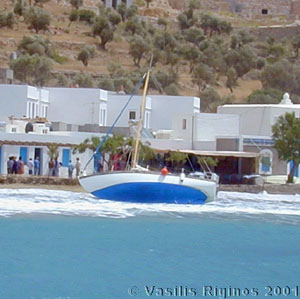
It is early in the afternoon: I was very tired and although there were a number of tasks waiting for my attention I was moving about slowly. The swell was still strong but the wind was now down to 16 knots.
We had a very exiting morning. Last night when I came in the anchorage there were 4 boats already anchored: a large motor-sailer and a large sail boat (both of them left early this morning) then there was a Dutch ketch, and a small French sailboat. This last one was anchored very close to the sandy shore. This morning I had noticed this boat bobbing up and down wildly in the swell that was breaking as it reached the shallow waters. One minute she was there moving up and down and the next she was washed ashore being hammered by the waves breaking over her broadside. I, along with the Dutch couple from the ketch, watched with the binoculars unable to do anything sensible so as to offer assistance because it was impossible to lunch a dinghy in this strong swell. All of this had happened very fast. Fortunately the good people of Sifnos rushed to her assistance. There was a lot of confusion but I could not hear anything, all sound was drowned by the surf. Lots of people waded around the boat. Ropes were fastened. As I watched, I saw people carrying a man from the sailboat ashore and placing him on a chair. Then more people manned the ropes and slowly dragged the boat, still on her sides, completely on the dry sand. It was very fortunate that this was a sandy beach, had it been rocks the boat would be a total loss. A short time later, an ambulance, with flashing lights, came running down the slope. All this was very disconcerting. I could not but think: but for the grace of the gods this could had been Thetis and I.
I slowly adjusted the tiller to avoid scraping sounds, cleaned and tightened the engine circuit breaker (which I suspected caused the intermittent circuit yesterday), and counted the damaged main sail slides. Six were broken. I replaced 4 of them, exhausting my spare supply. I then called my brother Nikos and asked him to please get me more spares as well as a new circuit breaker. I then called Manos and asked him to get these in addition to the flares and to bring them to Kythera.
I made a new longer cable for the new, heavy duty, autopilot actuator arm. Now I had with me: 3 autopilot controllers and 2 actuators. I wired the electronic counter for the new water meter but it did not work. We will have to see about this.
Night time: the wind was still blowing, now about 30 knots and the swell was strong. I cooked a turkey cutlet and ate it with pasta. I had to eat inside the cabin because it was too uncomfortable and cold in the cockpit.
Monday May 7, 2001, Day 4
It was windy and rough all night. The Navtex was still issuing gale warnings but no detailed forecast had been received. Infuriating! I managed to tune the AM radio and get a voice forecast: winds force 8-9 from the SW for today, for tomorrow, wind down to force 6 from the NW and diminishing. Maybe I will be able to sail tomorrow for Kythera. Now (9 AM) the temperature inside the cabin is 19°C (66.2°F), 75% relative humidity and the barometer 1005 mB, up from yesterday’s 1002. The wind is close to 40 knots.
Evening: I am getting tired of the surf and hope this uncomfortable weather will improve so that I can go to Kythera. But I am more rested today. I did several chores: I varnished the floorboards, I secured the sun shower and the horseshoe life preservers, I siphoned 25 L of fuel into the main tank, I cleaned all the inside wood surfaces with soap and fresh water, I vacuumed, etc.
In the early afternoon a large fishing boat came and towed the French sailboat from the beach into the water and then to the small quay. Later, the wind calmed down and there was less swell so I managed to launch the zodiac. In the evening, I went ashore and had a nice dinner at the reliable Tzikali. During dinner, I learned the story of the French boat Baladin II. She is owned by an “elderly” 58 year old Frenchman (I am older) who is completely paralyzed from the waist down. This had not prevented him from singlehandling her for several years. Yesterday his anchor chain snapped and she was washed ashore while he was unable to do anything sensible to prevent the disaster. He was evacuated by the local people but he was not injured. The ambulance that I saw was coming for a lady in labor and the timing was pure coincidence. The Frenchman tried to get a tow. The original price he was quoted was a cool 1 million GRD (about $2,500) but eventually the fishing boat Faneromeni agreed to tow his boat for only 500,000 GRD!
I received a new forecast from the Navtex. It called for more gale tomorrow but the wind will diminish by tomorrow night. I called Manos and told him that I am not going anywhere until the gale is over. If I cannot leave for Kythera by Wednesday he may have to meet me here in Sifnos.
Tuesday May 8, 2001, Day 5
It is noon and I am still here in Vathi but the wind is down to only 5-8 knots WNW, the barometer is also up to 1007 mB, but it is cool, 23°C (73.4°F) and the humidity is 58%. I slept very well and I did not get up until late in the morning. The latest Navtex report had canceled all the gale warnings and it was forecasting for the Kythera sea 6-7 NE and diminishing. I talked with my brother Nikos who had already called the weather service on my behalf and he also confirmed this forecast. The Greek weather service has a new telephone number where one can call and get specific forecasts but alas it does not work with mobile phones. If this weather pattern holds, I plan to depart for Kythera this evening around 6 PM. This should get us to Kythera, about 96 M from here, late in the morning. Manos’ flight, as I learned when I called with the new plan, is due in the early afternoon.
Around 5 PM, as I was preparing for departure, Nikos called and reported that in Voula (a suburb of Athens) there was strong wind and heavy clouds and some sprinkling. Here at Vathi however there was only a pleasant breeze, so I continued with my preparations.
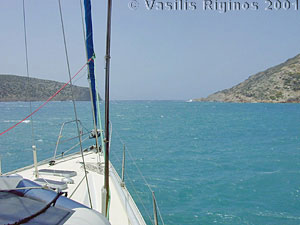
I departed from Vathi, Sifnos at 1810. At the beginning the sea and weather did not look very encouraging. The wind was 10-15 knots from the W while our course was 240°, right on our nose. The sea was very confused and there was a most uncomfortable chop. The prospect of motoring for over 90 miles with the extra attraction of banging and spray was not very thrilling. For a while I contemplated turning back but continued for the time being. When we were over a mile away from Sifnos the wind veered to NW and I was able to raise the main sail (I had already replaced 4 of the 6 broken slides). I kept the sail on its 3rd reef because I was still sensitized by my recent experience. I also opened some head sail but for the time being all I could do was motor-sail. Nevertheless it was much more comfortable than just motoring.
Half an hour later, at 1945, the wind veered further N and I was at last able to turn off the motor. By the time we had reached the island of Milos the wind had increased to 20-23 knots and, despite the reduced sails, Thetis was doing better than 7 knots. The full moon rose over Milos. It was a magnificent sight! The island silhouetted by the moon and the spray created all shades of silver as the boat raced across the waves. The waves by then, while large, were much more regular. A great sail!
Wednesday May 9, 2001, Day 6
We continued sailing in the rough moon-lit sea. As we approached Peloponnesos we encountered many ships but not in a collision course. It was a very pleasant night to be sailing.
Around 0200 we lost the wind. It decreased to only 10-12 knots and backed back to the W. Too weak for tacking so, in order to maintain our course, I had to start the motor and later I even had to roll-in the head sail.
About 0500, while it was still dark, I saw in the distance a very strangely illuminated ship in a reciprocal course to Thetis. I looked at her with the binoculars but I could not make out her navigational lights, they were overwhelmed by the illumination. All I could ascertain, mostly with the radar, was that we were not on a collision course but that we will have a fairly close approach. When we were almost 1.5 M apart, I could see, with the glasses, that she was a large four-masted sailing ship in full sails illuminated by strong flood lights. Still none of her navigational lights visible. Most irregular!
The dawn, when it came, was very beautiful. The sun, a huge fiery red disk on our stern, Cape Maleas, a brooding dark shadow on our right, and low lying Kythera, a slight pink, straight ahead. I was very glad that I did not turn back to Sifnos and kept going to be rewarded with this glorious sight.
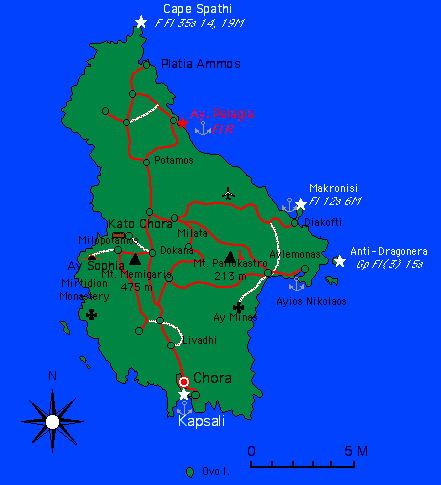 We entered the main harbor of Kythera, Kapsali (Καψάλι) [36° 08.4' N 23° 00' E] at 1100. We had covered 93.6 M. The harbor was totally empty of boats and people. It looked like a ghost town. The local breeze was about 11 knots from the E and away from the quay. Docking side-to unassisted was a little tricky because by the time Thetis would stop moving and I could jump ashore with a stern line and secure it, her bow would be blown away. The trick was to jump and tie the line while the boat had a slight headway, then run to the bow secure the bow line, and pull her ashore. It took three attempt before I accomplished these relatively simple tasks.
We entered the main harbor of Kythera, Kapsali (Καψάλι) [36° 08.4' N 23° 00' E] at 1100. We had covered 93.6 M. The harbor was totally empty of boats and people. It looked like a ghost town. The local breeze was about 11 knots from the E and away from the quay. Docking side-to unassisted was a little tricky because by the time Thetis would stop moving and I could jump ashore with a stern line and secure it, her bow would be blown away. The trick was to jump and tie the line while the boat had a slight headway, then run to the bow secure the bow line, and pull her ashore. It took three attempt before I accomplished these relatively simple tasks.
As soon as I had tied Thetis, an elderly gentleman with a fishing pole made his appearance. He was very surprised that a fellow Greek will be traveling all by himself on a sailboat. Only a slightly unbalanced foreigner would indulge in such outrageous behavior. He is a retired physics teacher. While talking with him, a Coast Guard officer appeared, as always too late to be of any help. His contribution was to inform me that I had tied down at the precise location where a cruise ship will be landing passengers early tomorrow morning so that I had to move. With the help of the physics teacher I warped Thetis 10 m further away and then tied her down securely with spring lines. The officer did give me a telephone number for water delivery and promised me to call himself for the fuel truck.
Kythera (Κύθηρα) is a small island of 2,500 inhabitants and over 10,000 immigrants to Australia. Tourism here is fairly low key. The sea of Kythera is the birthplace of Aphrodite, the goddess of love. According to the mythology she rose from the foam created from the genitalia of Uranos that his son Cronos threw into the sea after castrating him.
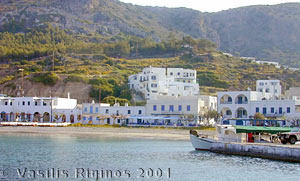
The first settlers on the island were Phoenicians. They traded in murex shells – Porphyre in Greek, which gave the island its other name Porhyrousa. The Phoenicians were followed by the Minoans. They made the island a trading center being at the cross roads between Crete and the mainland. This strategic location has made Kythera a very valuable property. The island has been invaded 80 times in recorded history. During the 10th century AD the island was continuously being invaded by Saracens from Crete to the point that its inhabitants abandoned it. The then Byzantine general and later emperor Nikephoros Phocas re-conquered Kythera and Crete from the Saracens. The rulers of the island were the Byzantine family Eudhaemonoyannis from Monemvasia. In 1204 AD the island was occupied by the Venetians but the emperor Michael Paleologos regained it and restored the Eudhaemonoyannis. In 1537 Barbarossa destroyed the island. The Venetians re-took it in the 16th century and re-named it Cerigo (Τσιρίγο) a name still used. The British followed the Venetians and in 1864, along with the other Ionian islands, ceded it to Greece. Today, for some mysterious bureaucratic reasons, the island is a province of Attica.
I was fairly hungry, so I made some rice and ate it with the last of the cutlets and a glass of cold beer. Then I took a nap. I woke up around 3 PM and took a hot shower. While still in the shower the fuel truck came. I re-filled the tank and the empty jerry can with 63 L of Diesel fuel.
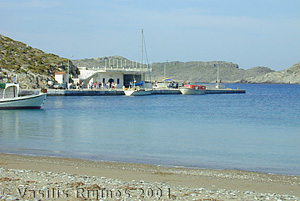
Later Manos arrived with a taxi. We shifted all sorts of things to empty the left cabin for him and converted the front cabin to a storage room. Usually I keep the left cabin for storage and the front for guests, but for a long passage I think the left cabin would be more snug. After Manos installed his things we deflated the zodiac and stowed it in the front cabin.
I called for a water delivery and then we both walked to the Coast Guard office and paid the harbor dues. Then Manos hoisted me up the mast to replace the bulb of the steaming light which had burned earlier this morning. Inevitably, the water delivery came while I was half way up the mast. In a typical Greek fashion, the water man helped Manos to crank the winch enjoying this rather novel experience. As soon as I had replaced the bulb and was down, we re-filled the water tanks and two spare jerry cans. Now, save for some food provisions, we are ready for the passage.
I spoke on the GSM phone to my brother Nikos and he will study the weather on the Internet and also call the weather service for a 4 day forecast. We later went ashore and had a pleasant ouzo to be followed by a good meal of green beans, feta cheese, dandelion salad, and a very fresh fish red porgy (φρανγόπουλο - pagrus pagrus). Kapsali is very attractive, especially so early in the season. Later I spoke with Nikos again. The weather situation was as follows: there is a high (1018 mB) in Sicily slowly moving E. The best forecast calls for low S winds for tomorrow and the day after but after that becoming stronger from the SE. We think that we should depart tomorrow, (after we get another report) because as long as the wind is not from the W, even if it gets as strong as 7 on the Beaufort Scale, we can handle it.